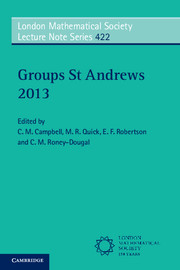Book contents
- Frontmatter
- Contents
- INTRODUCTION
- Approximate subgroups and super-strong approximation
- Width questions for finite simple groups
- Profinite properties of discrete groups
- GL(n, Z), Out(Fn) and everything in between: automorphism groups of RAAGs
- Permutation groups and transformation semigroups: results and problems
- New progress on factorized groups and subgroup permutability
- A survey on the normalizer problem for integral group rings
- A survey on Clifford-Fischer theory
- A generalisation on the solvability of finite groups with three class sizes for normal subgroups
- Automorphism groups of non-orientable Riemann surfaces
- What are the C2-groups?
- Resurrecting Wells’ exact sequence and Buckley's group action
- Recent work on Beauville surfaces, structures and groups
- Something for nothing: some consequences of the solution of the Tarski problems
- The groups of projectivities in finite planes
- On the relation gap and relation lifting problem
- Some results on products of finite subsets in groups
- Formal languages and group theory
- On the Castelnuovo-Mumford regularity of the cohomology of fusion systems and of the Hochschild cohomology of block algebras
- Recent advances on torsion subgroups of integral group rings
- On finite groups with small prime spectrum
- Solvability criteria for finite loops and groups
- The rational subset membership problem for groups: a survey
- A survey of Milnor laws
- Capable p-groups
- On the normal structure of a finite group with restrictions on the maximal subgroups
- Certain monomial characters and their normal constituents
- Recognition of finite quasi-simple groups by the degrees of their irreducible representations
- Generalized Baumslag-Solitar groups: a survey of recent progress
- Zeta functions of groups and rings – recent developments
Something for nothing: some consequences of the solution of the Tarski problems
Published online by Cambridge University Press: 05 September 2015
- Frontmatter
- Contents
- INTRODUCTION
- Approximate subgroups and super-strong approximation
- Width questions for finite simple groups
- Profinite properties of discrete groups
- GL(n, Z), Out(Fn) and everything in between: automorphism groups of RAAGs
- Permutation groups and transformation semigroups: results and problems
- New progress on factorized groups and subgroup permutability
- A survey on the normalizer problem for integral group rings
- A survey on Clifford-Fischer theory
- A generalisation on the solvability of finite groups with three class sizes for normal subgroups
- Automorphism groups of non-orientable Riemann surfaces
- What are the C2-groups?
- Resurrecting Wells’ exact sequence and Buckley's group action
- Recent work on Beauville surfaces, structures and groups
- Something for nothing: some consequences of the solution of the Tarski problems
- The groups of projectivities in finite planes
- On the relation gap and relation lifting problem
- Some results on products of finite subsets in groups
- Formal languages and group theory
- On the Castelnuovo-Mumford regularity of the cohomology of fusion systems and of the Hochschild cohomology of block algebras
- Recent advances on torsion subgroups of integral group rings
- On finite groups with small prime spectrum
- Solvability criteria for finite loops and groups
- The rational subset membership problem for groups: a survey
- A survey of Milnor laws
- Capable p-groups
- On the normal structure of a finite group with restrictions on the maximal subgroups
- Certain monomial characters and their normal constituents
- Recognition of finite quasi-simple groups by the degrees of their irreducible representations
- Generalized Baumslag-Solitar groups: a survey of recent progress
- Zeta functions of groups and rings – recent developments
Summary
Introduction
Alfred Tarski in 1940 made three well-known conjectures concerning nonabelian free groups (see Section 2). There had been various partial solutions until complete positive solutions were presented during the past 15 years by Kharlampovich and Myasnikov (see [51]–[59]) and independently by Z. Sela (see [78]–[83]). In the Kharlampovich- Myasnikov approach the proof arose from a detailed study of fully residually free groups (called limit groups in Sela's approach), the development of algebraic geometry over free groups, and an elimination process involving solutions of equations over free groups based on work of Makhanin and Razborov (see [51]–[59]). These steps were mirrored, with somewhat different terminology, by Sela, who called his approach diophantine geometry over free groups.
The positive solution of the Tarski conjectures provides a straightforward proof of Magnus's theorem in surface groups which we present. This result was proved directly by J. Howie [46] and independently by O. Bogopolski [10]. We will present this proof in Section 4. This type of proof leads to several different types of questions.
• Which additional nontrivial free group results are true in surface groups but difficult to obtain directly?
• What first-order properties of nonabelian free groups are true beyond the class of elementary free groups?
After showing a proof of Magnus's Theorem based on the solution of the Tarski problems we give several examples of other free group results holding in surface groups. Using this technique we give a proof of a theorem of D. Lee on C-test words. We then consider and prove certain other results that hold in elementary free groups, in particular surface groups, including the retract theorem of Turner [86] and the property of conjugacy separability.
After this we turn to the second type of question and survey a large number of recent results. In particular we first consider groups satisfying certain quadratic properties that we call Lyndon properties and show that the class of groups satisfying these properties are closed under many amalgam constructions.
- Type
- Chapter
- Information
- Groups St Andrews 2013 , pp. 242 - 270Publisher: Cambridge University PressPrint publication year: 2015



